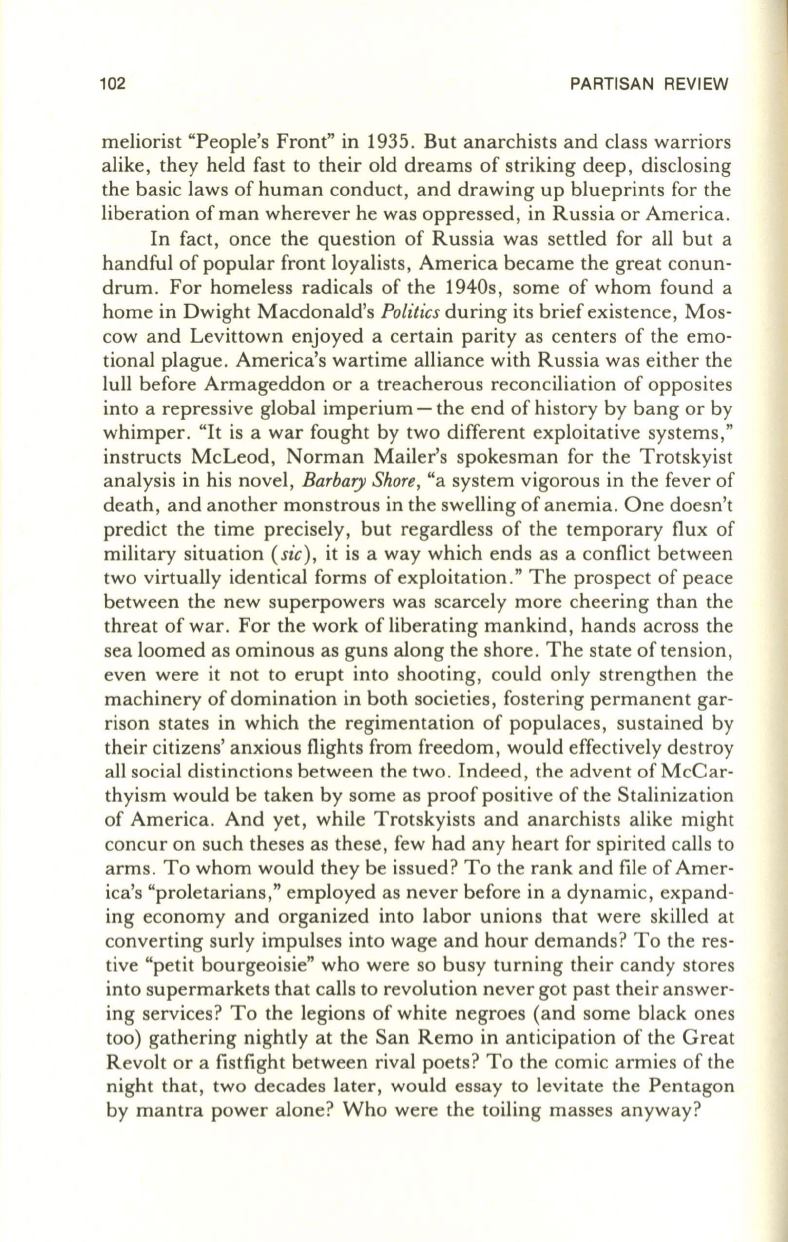
102
PARTISAN REVIEW
meliorist "People's Front" in 1935. But anarchists and class warriors
alike, they held fast to their old dreams of striking deep, disclosing
the basic laws of human conduct, and drawing up blueprints for the
liberation of man wherever he was oppressed, in Russia or America.
In fact, once the question of Russia was settled for all but a
handful of popular front loyalists, America became the great conun–
drum. For homeless radicals of the 1940s, some of whom found a
home in Dwight Macdonald's
Politics
during its brief existence, Mos–
cow and Levittown enjoyed a certain parity as centers of the emo–
tional plague. America's wartime alliance with Russia was either the
lull before Armageddon or a treacherous reconciliation of opposites
into a repressive global imperium - the end of history by bang or by
whimper. "It is a war fought by two different exploitative systems,"
instructs McLeod, Norman Mailer's spokesman for the Trotskyist
analysis in his novel,
Barbary Shore,
"a system vigorous in the fever of
death, and another monstrous in the swelling of anemia. One doesn't
predict the time precisely, but regardless of the temporary flux of
military situation
(sic),
it is a way which ends as a conflict between
two virtually identical forms of exploitation." The prospect of peace
between the new superpowers was scarcely more cheering than the
threat of war. For the work ofliberating mankind, hands across the
sea loomed as ominous as guns along the shore. The state of tension,
even were it not to erupt into shooting, could only strengthen the
machinery of domination in both societies, fostering permanent gar–
rison states in which the regimentation of populaces, sustained by
their citizens' anxious flights from freedom, would effectively destroy
all social distinctions between the two. Indeed, the advent of McCar–
thyism would be taken by some as proof positive of the Stalinization
of America. And yet, while Trotskyists and anarchists alike might
concur on such theses as these, few had any heart for spirited calls to
arms. To whom would they be issued? To the rank and file of Amer–
ica's "proletarians," employed as never before in a dynamic, expand–
ing economy and organized into labor unions that were skilled at
converting surly impulses into wage and hour demands? To the res–
tive "petit bourgeoisie" who were so busy turning their candy stores
into supermarkets that calls to revolution never got past their answer–
ing services? To the legions of white negroes (and some black ones
too) gathering nightly at the San Remo in anticipation of the Great
Revolt or a fistfight between rival poets? To the comic armies of the
night that, two decades later, would essay to levitate the Pentagon
by mantra power alone? Who were the toiling masses anyway?


